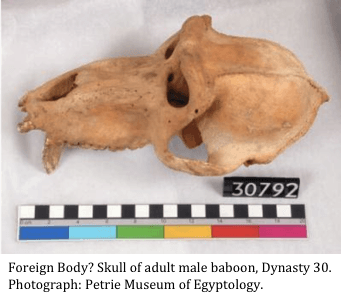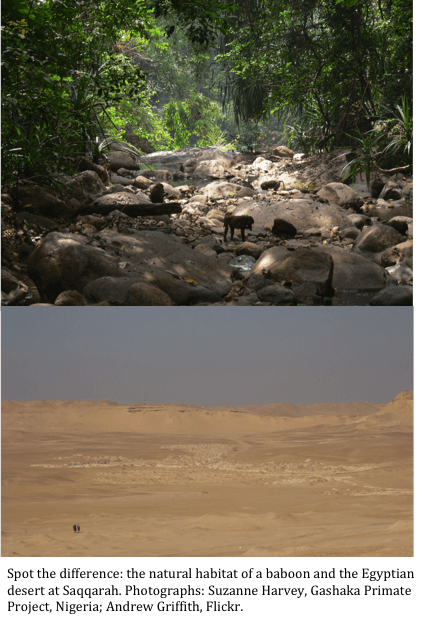From the Forests of Punt to the Deserts of Saqqara: Life and Death as a Sacred Monkey
By Gemma Angel, on 18 March 2013
 by Suzanne Harvey
by Suzanne Harvey
Given the wealth of figurines, statues, engravings and even mummies of baboons found in Egypt, it may seem odd that a baboon skull features as an object in our current Foreign Bodies exhibition in UCL’s North Cloisters.
 The key to this puzzle is that baboons are not, and never have been, indigenous to the areas of Egypt in which their remains have been found. They were imported from Nubia and the mysterious Land of Punt for use at temples and burial sites, where their habit of stretching and ‘chattering’ was viewed as worship of the Sun God, Ra. Since these animals were sacred to Gods of wisdom and the underworld, themselves deified in the form of Babi and The Great White One, and imported at great cost – surely their lives in Egypt would be ones of luxury?
The key to this puzzle is that baboons are not, and never have been, indigenous to the areas of Egypt in which their remains have been found. They were imported from Nubia and the mysterious Land of Punt for use at temples and burial sites, where their habit of stretching and ‘chattering’ was viewed as worship of the Sun God, Ra. Since these animals were sacred to Gods of wisdom and the underworld, themselves deified in the form of Babi and The Great White One, and imported at great cost – surely their lives in Egypt would be ones of luxury?
Life and death in a foreign land
The largest number of mummified baboons have been found at the tombs of Saqqarah, an arid desert environment that contrasts starkly with the natural forest and savannah habitat of baboons. In their natural environment, baboons spend most of their waking hours foraging for food in the form of leaves, seeds, fruit and insects, none of which would be possible in the desert. In fact, the environment of the temples and burial sites where baboons were kept, was so foreign to these species that most died from malnutrition, vitamin deficiencies, and fractured bones. Of around 200 mummies analysed, few had lived beyond 6-10 years, despite the natural lifespan of the sacred Hamadryas baboon being around 30 years.
From a primatological point of view, this highlights just how unsustainable desert colonies of baboons were. First breeding usually occurs between 5 and 7 years – with the majority of adults dying so young, it’s unlikely that much successful breeding took place at the temples. Recent studies at UCL’s Gashaka Primate Project have shown that diet has a strong effect on reproduction in baboons, with age of menarche, infant mortality and interbirth intervals all highly dependent upon nutrition.[1] In order to sustain a desert population of baboons, the Ancient Egyptians would have required constant imports of new animals, making baboons very rare and expensive offerings to the Gods.
The lost baboons of the Petrie Museum
In 2010, oxygen isotope analyses were carried out on hairs from one of the British Museum’s baboon mummies, and researchers were able to locate the Land of Punt, by comparing markers in the ancient baboon to modern samples. 3000 years after the baboon was mummified, his homeland was located as modern day Eritreia and Ethiopia, where baboons remain today.
The baboons at the Petrie Museum date from a later period than those at the British museum, and documentation indications that they were were mummified after voyages to Punt ceased. So for now, all we can really say for certain about the Petrie Museum baboons is that they were a long way from home when they died…
References
[1] J.P. Higham, Y. Warren, J. Adanu, B.N. Umaru, A.M. MacLarnon, V. Sommer, & C. Ross: (2009). ‘Living on the edge: Life-history of olive baboons at Gashaka-Gumti National Park, Nigeria’, in American Journal of Primatology, Vol. 71 (2009), pp.293-304.
 Close
Close



